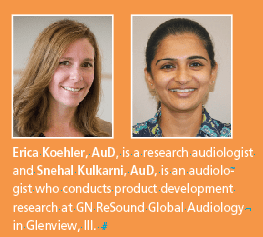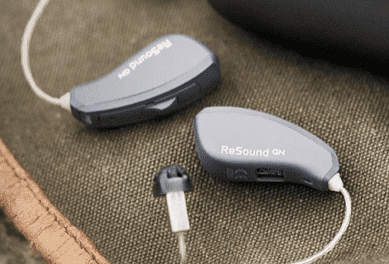Tech Topic: REM | October 2014 Hearing Review
By Erica D. Koehler, AuD, and Snehal Kulkarni, AuD
A new automatic REM fitting feature was found to be a reliable and fast alternative REM with less variability compared to manual REM.

Real-ear measurements have been known to positively affect patient experience. This is most likely due to improved audibility and increased satisfaction with the overall fitting experience.
Audibility as a Starting Point
The fitting software determines the amount of gain that is applied at various frequencies based on the audiogram and the selected fitting rule. The truth is that these prescribed settings are based on averages; the sound pressure level (SPL) at the patient’s eardrum is really just a “best guess” until actual measurements are made. Less than 12% of targets on the fitting software screen matched the actual measurements in the ear.1,2 Fitting software tends to overestimate the actual real-ear gain of hearing aids, especially in lower and higher frequencies.3
Real-ear measurements not only can be used to verify audibility, but also have been shown to contribute to a better experience for the patient, in turn achieving higher overall satisfaction.4 However, a 2010 survey conducted by Hearing Journal found that 60% of patients reported being fitted with hearing instruments without probe microphone verification measures, and less than 40% of audiologists said they “always or “nearly always” conducted the measurements.
Barriers and Solutions to REM Use
Why do hearing aid fitters routinely leave out this important step in verification? One reason could be that the perceived benefit relative to the time spent doing the procedure is low.
To explore this idea, an online survey was conducted by ReSound Global audiology: 42% of respondents working in a variety of clinical settings reported regular use of REM in their hearing aid fitting process, which is slightly higher than that reported in the Hearing Journal survey. Nearly 60% reported that they spend 60 minutes or less on initial fit appointments. Considering what must be accomplished during an initial fit appointment, it is understandable that clinicians would want to eliminate any procedures that do not add obvious value. A total of 55% of respondents indicated that an acceptable amount of time to spend on REM is less than 10 minutes. The vast majority (90%) of respondents stated that they would conduct REMs regularly if the measurements could be completed within a 5 to 10 minute timeframe.

[Click on images to enlarge.] Figure 1a-b. AutoREM guides the fitter through a step-by-step process to automatically match the REIG targets of the selected fitting rule.
The procedure automatically determines and applies gain corrections to meet prescriptive targets. This makes the process fast and simple. Aventa (versions 3.5 and later) communicates with the Otometrics Aurical Plus or FreeFit REM system to measure gain at the eardrum and automatically fine-tune the hearing aid gains to meet any prescriptive formula available in the Aventa 3 software. This includes not only the ReSound proprietary audiogram+ but also generic prescriptions such as DSL i/o, DSL 5, NAL-NL1, and NAL-NL2.
The feature follows the typical approach of taking real-ear insertion gain (REIG) measurements, including tube calibration and unaided and aided gain measurements. The REIG measures are compared to the target gain curves at 750, 1000, 2000, and 4000 Hz. As the speech noise stimulus is presented through the loudspeaker, the fitting software makes gain adjustments to the hearing instrument to achieve a target match within 5 dB, which is the recommended tolerance for these frequencies by the British Society of Audiology.
When used with the Otometrics FreeFit, both ears of a bilateral fitting can be measured and adjusted simultaneously. The fine-tuning adjustments can then be applied to the fitting and saved to the instrument.
The gains, as well as the real-ear measurements, will be saved in the Noah database for documentation and later review. The REM data can be opened in the Otometrics Aurical Plus REM module or Otosuite software.
Study of AutoREM System
To document the time-saving benefit to the clinician and to ensure a clinically acceptable target match, a study was conducted to compare the traditional method of fine-tuning to REM with AutoREM. The traditional method includes the REIG measurement, fine-tuning gains in fitting software, verifying again, and repeating the previous steps as necessary. The goal of this study was to answer the following questions: 1) when fine-tuning to target, is AutoREM faster than the traditional REM procedure? And 2) when comparing fine-tuning adjustments, does AutoREM provide results similar to those of the traditional manual procedure?
Methods. A total of 29 ears of 15 normal-hearing adult volunteer participants were fit with Comply Tips and Verso 977 behind-the-ear (BTE) devices. Each device was programmed to the same mild-to-moderate audiogram and with Audiogram + fitting prescription to rule out the audiogram as a variable. Each subject was fit to target with two sets of devices: one set of devices were manually fine-tuned and the other tuned with AutoREM. The instruments were matched acoustically before the study to rule out any differences in the devices themselves.
The 15 subjects were split into three groups (five subjects each). Three fitters were recruited and each assigned one group. The fitters conducted bilateral fittings on the five subjects in their respective groups in order to investigate whether differences in fitting speed or procedure among clinicians might have an effect. Fitter 1 was the least experienced of the 3 fitters, while 2 and 3 were routine users of REMs.
Fitters were asked to fit each subject twice, once using AutoREM and once using the manual “fine tune and measure” method using the Otometrics FreeFit to meet gain targets. No special training or instruction was provided. The fitters were asked to follow the AutoREM instructions in the Aventa 3 software for that part of the experiment.
For the manual procedure, the fitters were instructed to match the prescriptive targets using insertion gain measurements as they normally would. Each fitting was timed with a stopwatch by an individual not participating in the measurement. The timed session did not include probe-tube placement. Probe tubes were marked in advance with a marker at the appropriate depth in order to ensure the depth of the tube was consistent between measures. The timer began when the measurement application was clicked to launch, and completed when the fitter determined that the fitting met target gains. The hearing instruments were then measured in a 2cc coupler to allow comparison of the automatic versus manual fine-tuned adjustments. The coupler measurements were compared to determine the accuracy of the AutoREM procedure, with the manual fine-tuning serving as the gold standard.
Results and discussion. Significant time savings were seen with AutoREM when comparing the time the operators spent fitting to target with the manual method versus AutoREM. On average, the three fitters spent 3 minutes and 2 seconds fitting bilaterally with AutoREM compared to an average of 4 minutes and 9 seconds manually (Figures 2 and 3). This resulted in an average of 1.7 minutes, or 107 seconds, saved per bilateral fitting.

Figure 3. Fitters’ average time with manual fitting was over 4.5 minutes with greater variability. Time with AutoREM averaged about 3 minutes with less variability.
More variability regarding time was seen with the manual method. This may likely be due to the fact that some ears are “quicker fits” than others or that some fitters may be faster than others. Some of the individual REMs were very close to target on the first pass, but others required extensive fine-tuning and numerous repeated measurements to achieve a gain curve that was within 5 dB of target. Conversely, the automatic procedure adjusted gain during the measurements (up to three consecutive passes), streamlining the process, particularly for more difficult-to-fit ears.

Figure 4. Fitters who spent more time with manual fitting saw the most benefit in time savings with AutoREM. Two of the three fitters had much less variability in time spent using AutoREM compared to fine-tuning manually.
The data for each fitter are shown in Figure 4a-b. Several observations can be made based on this data. First, Fitter 1 spent the most time on the manual REM fittings. This was not surprising, as Fitter 1 was the least experienced with using REM. Fitter 3 had the fastest average time on the manual REM fittings, but the most variability. Fitter 2 spent less time than Fitter 1, but showed very little variability in time to match to targets.
Fitter 2 would see the least benefit with AutoREM compared to the other fitters because of Fitter 2’s relatively quick and consistent manual method. Fitter 2’s time saving averages only about 1 minute. However, Fitter 1 realized about a 3.5 minute time-savings with AutoREM, and Fitter 3 saves just under a minute, but more importantly has much less variability in time spent with AutoREM.

Figure 5. Average differences in fine-tuned gains between the manual and AutoREM procedures. Positive values mean that gains were adjusted higher with the manual method than with AutoREM.
Although the average time-savings may seem minor, it is important to remember that the design of the study was to isolate these time differences. The same hearing aids, coupling to the ear canal, and audiogram were used for all fittings. Real-life patients and fittings add to the complexity and variability of the process. The time-savings realized in actual clinical practice can be much greater than demonstrated here. In addition, because AutoREM automatically sets special features appropriately for REM and guides the fitter through the process, it means fewer things for the fitter to remember to do. This can add confidence for fitters who have not regularly been using REM as well.
The second question to be answered in this study was whether using AutoREM resulted in similar fine-tuned gains to match the targets. Figure 5 shows the average differences for all ears between the two methods. At 800 Hz and 1000 Hz, the fitters manually adjusted the gains approximately 2 dB higher than AutoREM. While this difference was statistically significant (p<0.05), it is not judged to be clinically significant. At 2000 Hz and 4000 Hz, the average differences in gains resulting from the two methods were less than .5 dB, and were not significant. This supports that the AutoREM feature can be expected to yield similar results to a manual fine-tuning to targets.
Summary
Many hearing aid fittings today are completed without verification via REM, despite the fact that use of REM is accepted as best practice in hearing aid fitting. The time allotted for many hearing aid initial fittings appears to be limited, and this may lead fitters to abandon practices that do not seem unequivocally linked to patient outcomes. Survey data revealed that most fitters agree on less than 10 minutes as an acceptable time investment for including REM routinely.
AutoREM is an automatic target-matching feature that is integrated in ReSound Aventa 3 fitting software and works with Otometrics real-ear systems. This study compared time spent and fine-tuned gain with AutoREM versus manual fine-tuning to match prescriptive targets. Both procedures were completed at an average time of less than 5 minutes. However, it should be considered that many real-world variables that affect the actual time taken were removed for this study in order to isolate time differences in the procedures. Each of the 3 fitters was able to achieve targets at the test frequencies with both procedures, but on average spent less time verifying with the AutoREM feature as compared to the conventional REM procedure.
Variability was much less for 2 of the 3 fitters with AutoREM. This suggests that using AutoREM could result in fewer “surprises,” where a fitting procedure takes much longer than anticipated and throws off schedules.
In conclusion, AutoREM is a reliable and fast alternative to manual real-ear measurements for those who find manual fine-tuning with real ear measurements time-consuming or overwhelming in the context of a busy initial fitting.
References
- Aarts NL, Caffee CS. Manufacturer predicted and measured REAR values in adult hearing aid fitting: Accuracy and clinical usefulness. Int J Audiol. 2005;44:239-301.
- Aarts NL, Caffee CS. The accuracy and clinical usefulness of manufacturer-predicted REAR values in adult hearing aid fittings. Hearing Review. 2005;12(12):16-22.
- Hawkins DB, Cook JA. Hearing aid software predictive gain values: How accurate are they? Hear Jour. 2003;56(7):26-34.
- Kochkin S. MarkeTrak VIII: Reducing patient visits through verification and validation. Hearing Review. 2011;18(6):10-12.
- Mueller G, Picou E. Survey examines popularity of real ear probe mic measures. Hear Jour. 2010;65(5):27-32.
About the authors: Erica Koehler, AuD, is a research audiologist and Snehal Kulkarni, AuD, is an audiologist who conducts product development research at GN ReSound Global Audiology in Glenview, Ill.
CORRESPONDENCE to Dr Koehler at: [email protected]
Original citation for this article: Koehler ED, Kulkarni S. Fast and easy fitting and verification with integrated real-ear measurement. Hearing Review. 2014;21(10)36-40.








